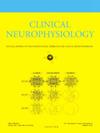阅读困难和典型读者对语音和时间规律的神经生理反应
IF 3.7
3区 医学
Q1 CLINICAL NEUROLOGY
引用次数: 0
摘要
目的对亚词汇语音特征的敏感性对成功的阅读发展至关重要。在这里,我们评估了典型和诵读困难的读者对形式(语音)和时间(音节重音)亚词汇语音规律的加工。方法采用被动脑电古怪范式对荷兰语成人读者、典型读者和诵读困难成人读者进行测试,并对荷兰语假词的音位化概率(形式)和音节重音(时态)进行控制。我们评估了失配负性(MMN)作为经验依赖变化检测的标记,以及theta频段中相关的相位重置。结果两种异常类型均诱发MMN。诵读困难的读者表现出对语音定向的神经敏感性降低,但对强调规则性没有影响。时间-频率分析表明,不同类型偏差的变化检测过程不同,形式偏差的δ / θ试验间一致性(ITC)增加,在阅读困难的读者中增强,而时间偏差的下降,在两组之间没有差异。结论失读症读者对语音规则的非典型敏感性,而对时间规则的非典型敏感性,不同异常类型的变化检测具有不同的振荡相关性。这是第一个同时评估荷兰成年失读症读者对语音和时间规律的神经敏感性的研究,并强调了对不同亚词汇特征的不同变化检测。本文章由计算机程序翻译,如有差异,请以英文原文为准。
Neurophysiological responses to phonological and temporal regularities in speech in dyslexic and typical readers
Objective
Sensitivity to sublexical speech features is important for successful reading development. Here we assessed the processing of formal (phonological) and temporal (syllable stress) sublexical speech regularities in typical and dyslexic readers.
Methods
We tested Dutch-speaking, typical and dyslexic adult readers in a passive EEG oddball paradigm, manipulating phonotactic probability (formal) and syllable stress (temporal) in Dutch pseudowords. We assessed the mismatch negativity (MMN) as a marker for experience-dependent change detection, as well as the associated phase-reset in the theta frequency band.
Results
Both deviant types elicited an MMN. Dyslexic readers exhibited reduced neural sensitivity to phonotactic, but not to stress regularities. Time-frequency analyses suggest distinct processes underlying change detection for different deviant types, with increased delta/theta inter-trial coherence (ITC) for formal deviants, which was enhanced in dyslexic readers, and a decrease for temporal deviants, which did not differ between groups.
Conclusion
Results suggest atypical sensitivity to phonological but not temporal speech regularities in dyslexic readers, and distinct oscillatory correlates underlying change detection for different deviant types.
Significance
This is the first study to simultaneously assess neural sensitivity to phonological and temporal regularities in Dutch adult dyslexic readers and highlights distinct change detection for different sublexical features.
求助全文
通过发布文献求助,成功后即可免费获取论文全文。
去求助
来源期刊

Clinical Neurophysiology
医学-临床神经学
CiteScore
8.70
自引率
6.40%
发文量
932
审稿时长
59 days
期刊介绍:
As of January 1999, The journal Electroencephalography and Clinical Neurophysiology, and its two sections Electromyography and Motor Control and Evoked Potentials have amalgamated to become this journal - Clinical Neurophysiology.
Clinical Neurophysiology is the official journal of the International Federation of Clinical Neurophysiology, the Brazilian Society of Clinical Neurophysiology, the Czech Society of Clinical Neurophysiology, the Italian Clinical Neurophysiology Society and the International Society of Intraoperative Neurophysiology.The journal is dedicated to fostering research and disseminating information on all aspects of both normal and abnormal functioning of the nervous system. The key aim of the publication is to disseminate scholarly reports on the pathophysiology underlying diseases of the central and peripheral nervous system of human patients. Clinical trials that use neurophysiological measures to document change are encouraged, as are manuscripts reporting data on integrated neuroimaging of central nervous function including, but not limited to, functional MRI, MEG, EEG, PET and other neuroimaging modalities.
 求助内容:
求助内容: 应助结果提醒方式:
应助结果提醒方式:


